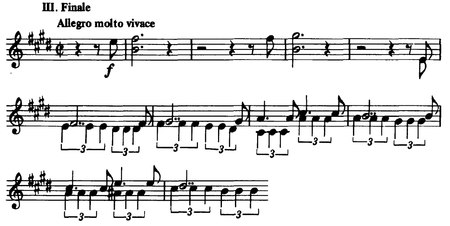The Overture, Scherzo and Finale ( German: Ouvertüre, Scherzo und Finale) in E major is a work for symphony orchestra by Robert Schumann. It is his opus 52, and was written in 1841. Schumann originally considered it his second symphony. [1] The Overture, Scherzo and Finale was received tepidly by critics, [1] was revised in 1845 [2] and published the next year, [2] with a dedication to Johannes Verhulst.
Structure
The work is in three movements:
- Overture. (
Andante con moto in
E minor
[2] – Allegro in E major and
 time
[3]) (sketched and completed in April 1841)
[1]
time
[3]) (sketched and completed in April 1841)
[1]
-
Scherzo. Vivo, in 6
8 time and in C♯ minor, [4] whose theme is based on that of the overture. [1] It has a trio section in D♭ major, in contrasting 2
4 time [5] whose material reappears as the coda of the movement. [6]
- Finale. Allegro molto vivace
[2] (orchestrated around May 1841)
[1]

Recordings
- Paul Kletzki conducting the Israel Philharmonic Orchestra
- John Eliot Gardiner conducting the Orchestre Révolutionnaire et Romantique
- Wolfgang Sawallisch conducting the Sächsische Staatskapelle Dresden
- Herbert von Karajan conducting the Berliner Philharmoniker
- Sir Georg Solti conducting the Wiener Philharmoniker
- Franz Konwitschny conducting the Gewandhausorchester Leipzig
- Carl Schuricht conducting the Orchestre de la Société des Concerts du Conservatoire
- Lawrance Collingwood conducting the London Symphony Orchestra, 1953 [7]
- Gerard Schwarz conducting the Seattle Symphony
References
- ^ a b c d e Daverio, John (1997). Robert Schumann: Herald of a "new Poetic Age" at Google Books. Oxford University Press U.S. Pages 235-6. ISBN 0-19-509180-9.
- ^ a b c d Ferguson, Donald N. (1968). Masterworks of the Orchestral Repertoire: A Guide for Listeners at Google Books. U. of Minnesota Press. Page 518. ISBN 0-8166-0467-3.
- ^ See score, bar 18 - pages 2-3 of the piano 4-hands arrangement.
- ^ Pages 16-7 of the piano 4-hands arrangement, for example.
- ^ starting middle of bar 55, to bar 71 - pages 18-9 of the piano 4-hands arrangement.
- ^ starting at bar 137 - pages 24-5 of the piano 4-hands arrangement.
- ^ Discographical data from 'Collingwood' search in The CHARM Discography, Centre for the History and Analysis of Recorded Music, < http://www.charm.kcl.ac.uk/about/about_structure Archived 2013-12-02 at the Wayback Machine>, accessed 12 January 2015.

